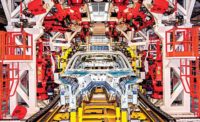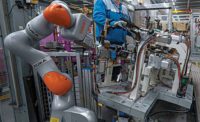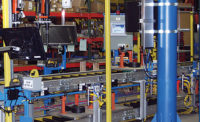Since 2016, China has been the world’s largest industrial robot market. Reports from the International Federation of Robots show that foreign robot makers sold nearly 90,000 units to Chinese manufacturers that year and more than 103,000 robots in 2017—with most of the robots being used by the country’s automakers.
For example, Changan Ford Automobile Co. Ltd. (CFAC) operates a large number of robots at its plants in Chongqing, Hangzhou and Harbin. CFAC was formed in December 2012 after a restructuring of Changan Ford Mazda, whereby Ford and Mazda agreed to work with Changan in separate joint ventures.
In July 2015, ABB was awarded a $52 million contract to provide the Harbin plant with a complete body-in-white (BIW) welding line to help make the Ford Focus. This line features many large IRB 6700 and IRB 7600 six-axis robots, as well as advanced systems for laser welding, car-body positioning and conveying, and door and roof production. CFAC selected ABB because the two companies have worked together since 2007, when ABB installed robots in several Chongqing plants to help produce the Ford Mondeo.
IRB 6700 robots have a payload capacity of 150 to 300 kilograms, and reach from 2.6 to 3.2 meters, making them ideal for spot welding, material handling and machine tending applications. There are 10 models in the series, all of which may be floor mounted or inverted, and offer an uptime of 400,000 hours between failures.
IRB 7600 robots have a payload capacity of 150 to 630 kilograms, along with high torque, inertia and acceleration capabilities. Other benefits include short cycle times, accuracy, durability (for harsh production environments) and integration flexibility.
To ensure personnel safety around this robot, ABB offers it with the SafeMove2 group of safety functions. These include speed limits, standstill monitoring, specific axis ranges, and position and orientation supervision.
Both models feature a LeanID dressing that integrates the most exposed parts of the dress pack into the robots. This dressing also makes it easier for operators to program the robots, creates a smaller footprint, and lessens maintenance due to wear and tear.
Complementing the robots on the welding line are numerous FlexLean technology systems. The GateFramer positioning system can produce up to six vehicle models on the same line, with just 18 seconds needed to switch to a different model.
The Roller Hemming system hems together the outer and inner panels of the vehicle’s four doors and roof. It controls the hemming pressure along each part’s entire flange, regardless of length and angle, resulting in consistently high-quality assemblies. The hemming path can be programmed offline to reduce onsite programming and trial-out time.
The line’s conveyor system features FlexTrack material handling tracks and FlexLifter vertical lifters. Although compact, the tracks handle loads up to 3,000 kilograms and are capable of high acceleration and accurate positioning of parts or robots. The lifters accurately raise or lower workpieces, and, when used with FlexTrack tracks, form an effective lift-and-carry transfer system.
ABB industrial robots have been used in the automotive industry since the mid-1980s for welding, stamping and painting, as well as powertrain and BIW assembly. Automotive industry customers besides Ford include BMW, Honda, Volvo and the Great Wall Motor Co.
For more information on six-axis robots and welding line systems, call 800-435-7365 or visit https://new.abb.com/products/robotics.





